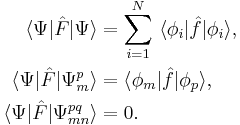Slater–Condon rules
Within computational chemistry, the Slater–Condon rules express integrals of one- and two-body operators over wavefunctions constructed as Slater determinants of orthonormal orbitals in terms of the individual orbitals. In doing so, the original integrals involving N-electron wavefunctions are reduced to sums over integrals involving at most two molecular orbitals, or in other words, the original 3N dimensional integral is expressed in terms of many three- and six-dimensional integrals.
The rules are used in deriving the working equations for all methods of approximately solving the Schrödinger equation that employ wavefunctions constructed from Slater determinants. These include Hartree-Fock theory, where the wavefunction is a single determinant, and all those methods which use Hartree-Fock theory as a reference such as Møller-Plesset perturbation theory, and Coupled cluster and Configuration interaction theories.
The Slater–Condon rules hold only for orthonormal orbitals. Generalization to allow for non-orthogonal orbitals was done by Per-Olov Löwdin, leading to what is known as the Löwdin rules.
Contents |
Background
In terms of an antisymmetrization operator ( ) acting upon a product of N orthonormal spin-orbitals (with r and σ denoting spatial and spin variables), a determinantal wavefunction is denoted as
) acting upon a product of N orthonormal spin-orbitals (with r and σ denoting spatial and spin variables), a determinantal wavefunction is denoted as
A wavefunction differing from this by only a single orbital (the m'th orbital) will be denoted as
and a wavefunction differing by two orbitals will be denoted as
For any particular one- or two-body operator, Ô, the Slater–Condon rules show how to simplify the following types of integrals:[1]
Matrix elements for two wavefunctions differing by more than two orbitals vanish unless higher order interactions are introduced.
John C. Slater originally derived expressions for diagonal matrix elements of an approximate Hamiltonian while investigating atomic spectra within a perturbative approach.[2] The following year Edward Condon extended the rules to non-diagonal matrix elements.[3] Per-Olov Löwdin further generalized these results for wavefunctions constructed from non-orthonormal orbitals.[4]
Integrals of one-body operators
One body operators depend only upon the position or momentum of a single electron at any given instant. Examples are the kinetic energy, dipole moment, and total angular momentum operators.
A one-body operator in an N-particle system is decomposed as
The Slater–Condon rules for such an operator are:[1][5]
Integrals of two-body operators
Two-body operators couple two particles at any given instant. Examples being the electron-electron repulsion, magnetic dipolar coupling, and total angular momentum-squared operators.
A two-body operator in an N-particle system is decomposed as
The Slater–Condon rules for such an operator are:[1][5]
where
References
- ^ a b c Piela, Lucjan (2006). "Appendix M". Ideas of Quantum Chemistry. Amsterdam: Elsevier Science. ISBN 0444522271.
- ^ Slater, J. C. (1929). "The Theory of Complex Spectra". Phys. Rev. 34 (10): 1293–1322. Bibcode 1929PhRv...34.1293S. doi:10.1103/PhysRev.34.1293. PMID 9939750.
- ^ Condon, E. U. (1930). "The Theory of Complex Spectra". Phys. Rev. 36 (7): 1121–1133. doi:10.1103/PhysRev.36.1121.
- ^ Löwdin, Per-Olov (1955). "Quantum Theory of Many-Particle Systems. I. Physical Interpretations by Means of Density Matrices, Natural Spin-Orbitals, and Convergence Problems in the Method of Configurational Interaction". Phys. Rev. 97 (6): 1474–1489. Bibcode 1955PhRv...97.1474L. doi:10.1103/PhysRev.97.1474.
- ^ a b Szabo, Attila; Ostlund, Neil S. (1996). "Ch. 2.3.3". Modern Quantum Chemistry : Introduction to Advanced Electronic Structure Theory. Mineola, New York: Dover Publications. ISBN 0486691861.








